|
|
|
|
|
|
|
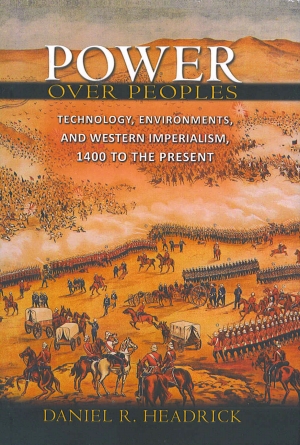 Fighting The Right War Fighting The Right War
In The Wrong
Way
ower Over Peoples
by Daniel R. Headrick shows how
advances in navigation and innovations in technology, evolving
over the centuries, have aided conquerors to lord over foreign
territories and defenders to ward off such aggressors. The small
kingdom of Portugal, with a million people in the 15th
century, became a world power that paved "the way for all the
empires that followed." What they discovered was not India or
Arabia, which they already knew about from travelers, but the
Atlantic Ocean and a means of crossing it."
But technology can only
go so far. The United States had overwhelming power in the air
and on the ground in Vietnam, yet lost the war. It lost due
to the corruption of the South Vietnam government and the determination
of the Vietnamese people to rid themselves of their foreign
occupiers (Japanese, French and American).
The U.S. lost because
it was glued to a military culture unsuited to a counterinsurgency
war. The Pentagon insisted that wars are won by machines (of
the air force and navy), and the more lethal the swifter the
victory. But these high tech weapons were effective only against
the environment and the civilian population—not the North Vietnamese
government and army.
They failed to develop
new skills to fight a new kind of enemy. As President Richard
Nixon concluded, "They made the mistake of fighting an unconventional
war with conventional tactics."
In words that resonate
today over the allied efforts in Iraq and Afghanistan, Headrick,
professor emeritus of social science and history at Roosevelt
University, concludes that the United States lost the war in
Vietnam because "it could not change the way it believed wars
should be fought and because, for domestic political reasons,
it could not send to war the millions of soldiers (or commit
the mass atrocities) that defeating such a determined foe would
have required." (Princeton, 412 pages,
$35.00
Amazon.com Price: $28.91)
|
|
Back to Top
|
|
|
|

Dan Buettner
Photo by Tim
Boxer |
Happiest Hotspots On The Planet
AN BUETTNER traversed the globe
in search of Blue Zones, places where people lived the longest.
A combination of diet, lifestyle and attitude enabled people
in Sardinia, Italy; Okinawa, Japan; Loma Linda, California,
and the Nicoya Peninsula, Costa Rica, to live more than a hundred
years. His research was published two years ago in the book
The Blue Zones.
(National
Geographic, softcover, 279 pages, $14.95
Amazon.com Price: $10.17)
Now Buettner, who lives
in Minneapolis, has completed another project: what communities
produce the happiest people on earth?
Thrive: Finding Happiness
the Blue Zones Way
is Buettner’s latest book in which he reveals that, contrary
to popular belief, Bhutan is not the happiest place in the world.
Denmark claims that distinction.
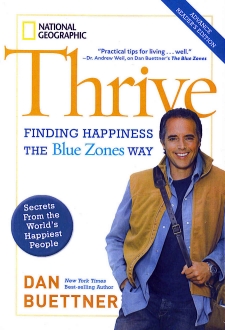 The biggest variable
is not who you married but where you live," Buettner said at
a National Geographic press reception in May at BookExpo America
in the Javits Center. The biggest variable
is not who you married but where you live," Buettner said at
a National Geographic press reception in May at BookExpo America
in the Javits Center.
After Denmark, the places
that produce the happiest people are Singapore; San Luis Obispo,
California; Monterrey, Mexico, "the happiest piece of real estate
in the entire Western Hemisphere."
Buettner identifies six
life domains that shape our chances for happiness. He calls
these interconnected domains Thrive Centers: community
(which should help you live out your values), workplace
(is it meaningful?), social life (acquire the right type
of friends), financial life (your saving or spending
strategies), home (which should favor happiness),
self (education, sense of purpose, health).
This is an engaging
book that could change your outlook and lead to a happier
life.
(National
Geographic, hardcover,
$26.00
Amazon.com Price: $17.16)
|
|
Back to Top
|
|
|
|

Jonathan Brent and Gershon Hundert
Photo by Tim
Boxer |
Preserving The Past For The Future
IVO Institute for Jewish Research was founded
in 1925 in Vilna, Poland (now Vilnius, Lithuania), to build
an archive of the Jewish experience for future generations.
Today based in New York, it is engaged in research, teaching,
documentation and publication (www.yivo.org).
Two years ago the institute
completed a monumental project to document every aspect of Jewish
life in Eastern Europe. It is a two-volume set,
Yivo Encyclopedia of Jews in Eastern Europe,
under the editorship of Gershon David Hundert, a professor of
Jewish studies at McGill University in Montreal. (Yale
University Press, 2,448 pages, 57 color illustrations, 1,104
B&W illustrations, 55 maps,
$400.00
Amazon.com Price: $357.330)
Hundert said the book
covers the area east of Germany and north of the Balkans. The
Balkans are Sephardic territory and the book focuses on the
Ashkenazim.
"We have 1800 entries
from 450 scholars in 18 countries contributing in 10 languages,"
Hundert said at a reception at Yivo offices in Manhattan to
launch the book’s website:
www.yivoencyclopedia.org.
"The website will secure
the electronic future of the Jews of Eastern Europe," said Jonathan
Brent, Yivo’s executive director/CEO. "This is the most credible
source of information on the Jews of Eastern Europe. It’s a
different version of the book, more inclusive—and free."
|
|
Back to Top
|
|
|
|
 Mastering Social Networking Mastering Social Networking
ONNECTING with people no longer means hanging
out on the street corner, mingling at the pool hall or even
dialing the phone. Today you are social networking in a myriad
of ways, and you need guidance (I certainly do).
Tim O’Reilly and Sarah
Milstein have authored one of the best instructional paperbacks
on the market to get you up and running. In
The
Twitter Book they take
you by the hand and show you how to get started. They are patient,
friendly, witty and utterly knowledgeable. You’ll be tweeting
and retweeting in no time.
 Tim is the founder and
CEO of O’Reilly Media, publisher of the best and most informative
books in the computer universe. (O’Reilly, softcover, 234
pages, $19.99
Amazon.com Price: $13.59) Tim is the founder and
CEO of O’Reilly Media, publisher of the best and most informative
books in the computer universe. (O’Reilly, softcover, 234
pages, $19.99
Amazon.com Price: $13.59)
LET’S say you want to
join the revolution and enter the realm of Facebook with its
400 million users. The book you want is
Facebook:
The Missing Manual by
E.A. Vander Veer. She has written for many outlets, including
Salon, The Writer and CNN.com. A vital chapter deals with adjusting
privacy settings so you don’t fall prey to privacy thieves.
She’ll help you judge how much to share so you avoid getting
ripped off by cloud pirates sailing the Internet in search of
your vital identity. Pay attention here. (O’Reilly, softcover,
257 pages, $19.99
Amazon.com Price: $13.59)
 TAKE a step-by-step tour
of such sites as Facebook, Blogger, LinkedIn, YouTube, Flickr,
MySpace, Ning, Meetup, Second Life and Google. So many opportunities,
but you have a good guide in Todd Kelsey’s
Social Networking Spaces: From Facebook
to Twitter and Everything in Between. TAKE a step-by-step tour
of such sites as Facebook, Blogger, LinkedIn, YouTube, Flickr,
MySpace, Ning, Meetup, Second Life and Google. So many opportunities,
but you have a good guide in Todd Kelsey’s
Social Networking Spaces: From Facebook
to Twitter and Everything in Between.
Every site he describes
starts off with a "What the heck" factor, such as "What the
heck is a blog?" and "What the heck is Ning." You can check
out the author on Facebook. "In my opinion," he says, "one of
the coolest things you can do on Facebook is share your life
story through pictures." For privacy, Kelsey shows you how to
control who sees your output, which is crucial when so many
on the planet are poised to steal your identity. (Apress,
softcover, 509 pages,
$29.99
Amazon.com Price: $26.99)
 AND for the rest of us,
we can turn to AND for the rest of us,
we can turn to
Twitter for Dummies.
Actually it took three brains—Laura Fitton, Michael E. Gruen
and Leslie Poston—to produce this book. Tweeter founder and
chairman Jack Dorsey even endorses the Dummies tract with an
encouraging foreword: "Let’s be honest: You’re nota dummy."
Easy for him to say. In the irreverent Dummies style, the authors
instruct in a very personable, friendly manner. The cartoons
help keep you amused chapter by chapter. A very enjoyable book.
(Wiley, softcover, 266 pages,
$21.99
Amazon.com Price: $14.84)
|
|
Back to Top
|
|
|
|
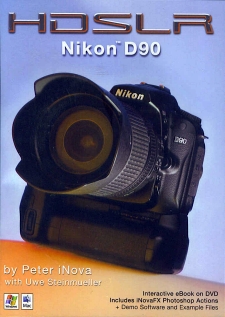 Ebooks For Nikon D90 Enthusiasts Ebooks For Nikon D90 Enthusiasts
WO DVDs from GM Books will mightily
enhance your capabilities with the Nikon D90.
HDSLR Nikon D90
is a must-have
for every owner or aspiring owner of this great camera. The
instructions in the DVD are designed to be interactive. Authors
Peter iNova and Uwe Steinmueller also produced helpful interactive
ebooks on the Nikon D80 and D300 (which I have and happily refer
to).
The techniques they discuss
are very easy to follow, especially with the roll-over effect.
Place your mouse on an illustration and you instantly get before
and after pictures to comprehend the control and menu items
under study.
The two chapters discussing
how to shoot RAW are invaluable. (GMbooks.com,
Amazon.com Price: $49.95)
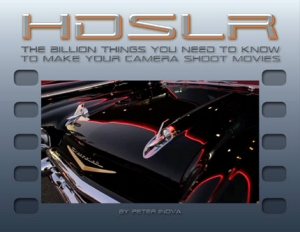 HDSLR: Things You
Need To Know
is another Peter iNova interactive ebook
for photographers who shoot in HD movie mode. There’s lots to
learn about time for people used to shooting still images. Nikon,
Canon, Pentax and Panasonic make HDSLR cameras. If you have
one, this is the DVD ebook you must have to learn this new form
of picture making. HDSLR: Things You
Need To Know
is another Peter iNova interactive ebook
for photographers who shoot in HD movie mode. There’s lots to
learn about time for people used to shooting still images. Nikon,
Canon, Pentax and Panasonic make HDSLR cameras. If you have
one, this is the DVD ebook you must have to learn this new form
of picture making.
The book will help you
with such topics as (among many others): What questions do moving
images need to answer different from those answered by stills?
Do the words "Ken Burns" mean a suntan accident or an essential
HD movie technique? How do you adapt Hollywood tools with your
camera? What accessories should you avoid?
There are sections on
stability, scene development, editing and effects to help you
achieve spectacular videos. More than 100 embedded movies provide
lots of examples of features introduced and discussed. (GMbooks.com,
$34.95)
|
|
Back to Top
|
|
|
|
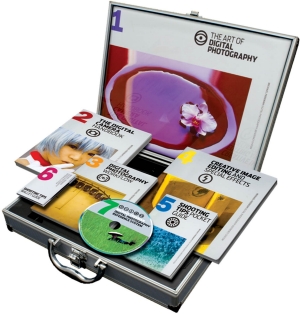 A Metal Case That Carries You A Metal Case That Carries You
Into
The World of Photography
HE most impressive and eye-popping
book to land on our desk is actually a metal case neatly packed
with six books plus a DVD from
Digital Photography
Reference System,
under the editorship of photographer Michael Freeman, is most
impressive and a welcome gift for any camera enthusiast, beginner
or advanced.
This library in a professional-looking
silver carrying case consists of six full color books. The first
is a 144-page hardcover explanation of The Art of Digital
Photography. You might capture a great image—great in composition
and lighting—but it won’t necessarily be a work of art, Freeman
insists. "Art is not a measure of excellence. There’s enough
poor art around to puncture that belief. Art begins, in our
case, with the photographer’s aim." Forget about making art;
just be an artist—and Freeman will help you on the way.
Freeman’s Book 2,
The Digital Camera Handbook (144 pages) covers such topics
as exposure, metering, histograms and everything else you need
to know to make perfect pictures.
Book 3 on Digital
Workflow (96 pages), by John Beardsworth, deals with metadata,
picture files such as RAW and jpeg, the three types of workflow
programs (such as Adobe Bridge, Picasa and Lightroom) and what’s
best for you, and backup and recovery.
Book 4 is the
spiral bound Creative Image Editing and Special Effects
(160 pages) wherein Freeman shows how to use software such as
Photoshop, Lightroom and Aperture to process and manipulate
your capture one image at a time: coloring eyes, enhancing teeth,
removing hotspots, you get the picture. For all that you must
shoot Raw.
Freeman includes a
Shooting Tips Pocket Guide (64 pages), and even a foldout
Shooting Tips Wallet Guide (12 sides)—plus a 50-minute
DVD tutorial with Freeman offering valuable expertise in studio
and on location. This package is an amazing pathway to the world
of creative photography. (Focal Press,
$89.95
Amazon.com Price: $56.67)
|
|
Back to Top
|
|
|
|
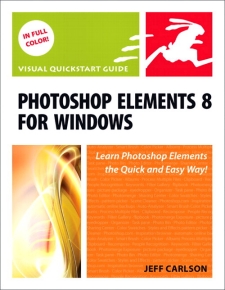 Photoshop Elements Handbooks Photoshop Elements Handbooks
NTIL this year I’ve been
using Photoshop Elements 2, and it has served me well. Then
I switched to Elements 4, and for my purposes it is adequate.
But Adobe keeps upgrading its product and now they’re up to
level 8. So for everyone who’s up to date, the Visual Quickstart
Guide you need is
Photoshop
Elements 8 for Windows.
It’s from Peachpit Press which specializes in such tech subjects.
The author, Jeff Carlson, is a technology columnist for the
Seattle Times and managing editor TidBits weekly online newsletter.
The easily readable book is profusely illustrated with color
and a joy to follow. (Peachpit
Press, softcover, 367 pages, $29.99
Amazon.com Price: $19.79)
 IF you’re already familiar
with Photoshop Elements, and need help to step up to Elements
8, then an excellent instructor is Mark Galer, an official Adobe
ambassador. His IF you’re already familiar
with Photoshop Elements, and need help to step up to Elements
8, then an excellent instructor is Mark Galer, an official Adobe
ambassador. His
Adobe Photoshop Elements 8: Maximum
Performance will serve
for Elements 7 as well. Galer guides you through seven projects:
from Adobe Camera Raw and Curves and Sharpness to Printing.
Very well written and easy to follow. The included DVD is a
wonderful bonus, consisting of even hours of movie tutorials
plus a library of 100 royalty-free images or your use, and printable
PDF files of keyboard shortcuts to speed up your image editing
tasks. (Focal Press/Elsevier, softcover, 335 pages,
$44.95
Amazon.com Price: $29.67)
|
|
|
|
|